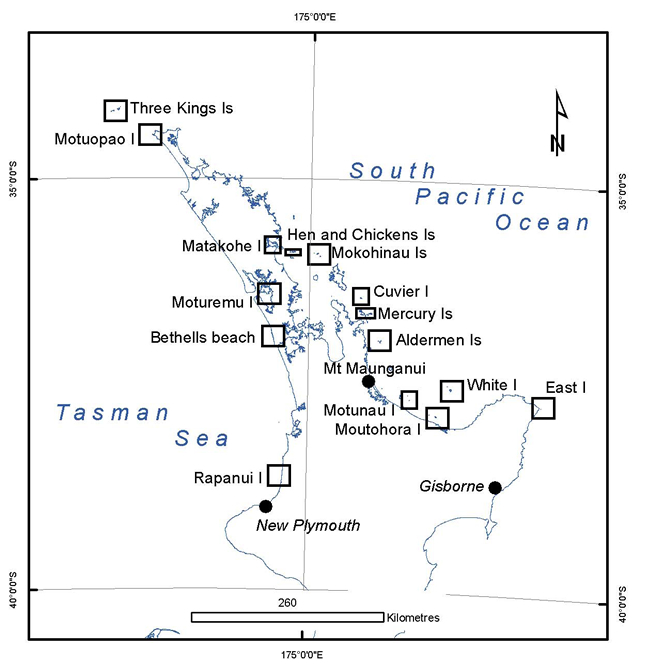Oi lifecycle

Oi chick
The oi is the most common petrel breeding around the middle and northern sections of the North Island coast. Its range extends from the Three Kings Islands in the north down almost as far south as New Plymouth along the west coast and Gisborne on the east coast (see Distribution Map).
Oi breed in colonies on headlands and islands within its range. On the map, we have highlighted some of the breeding colonies found on offshore islands around the North Island coast. Some of the larger colonies are located on the Ruamaahua Island group and Moutohora Island as well as the Mokohinau, ercury and White Islands.
 |
| Oi distribution map |
At sea, the oi is usually seen alone or in small groups. It is a nocturnal bird, so flies to its feeding grounds only at sunset and sunrise. The oi usually feeds in the open ocean, at least 100 kilometres from the coast, but was thought not to migrate far from New Zealand waters. However, the research has shown that oi cross the Tasman Sea to feed close to the eastern coast of Australia. Most birds feed on the surface of the sea or by dipping from the air. They feed mainly at night, so prefer prey that are “bioluminescent” (animals that give off light). Squid, small fish and crustaceans are the oi’s favourite food items. Adult oi are generally around 41 centimetres long and weigh about 550 grams. Previous studies have found that less than 6% of breeding birds die each year and that most live to be 16 years old. However, the oldest adult ever recorded was over 26 years old!
Oi breeding timetable
Unlike most of New Zealand’s seabirds, Oi breed in the winter. Breeding starts when adult birds return to the islands in March and April to court (most birds are at least 7 years old before they start breeding.) During this period, the males clean out the burrows and prepare the nests. The burrows are 0.5 to 3.0 metres long and usually under scrub or forest. Nests are lined with leaves and twigs, but are sometimes bare.
Honeymoon and incubation
After mating the adult birds embark on a pre-laying “honeymoon” of 50–60 days, when they leave their breeding colonies and go back to sea. The females are the first to return to the breeding colonies to lay an egg (21 June – 29 July). They usually incubate the egg for about 4 days, before the males return. Then the male and female take turns incubating for about 16-day shifts, but the egg may be left unattended for up to 5 days in between shifts. To help adult birds compensate for weight loss while on an incubating shift, they can gain an extra 100–200 grams in weight prior to taking their turn!
Hatching and fledging
Chicks hatch about 55 days after the eggs are laid (mid-August to mid-September). An adult guards the newly hatched chicks only for the first 3 days or so. After that, the adults only visit the nest once about every 4 nights to feed the chick. During this early stage, the chicks are covered in grey downy feathers. As chicks get older they slowly develop their flight feathers. Older chicks often come out of their burrows to exercise their wings and explore for several nights before leaving the colony. Chicks can fledge from any time between late November and late January, although most depart some time between mid and late December when they are about 118 days old. Oi chicks are a bit smaller than their tītī cousins (sooty shearwater) found on the Titi Islands around Rakiura (Stewart Island) and generally weigh less than 900 grams, although the occasional fatty might bust the 1100-gram mark.
